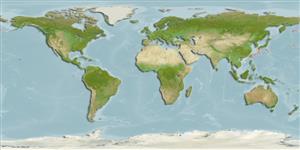Teleostei (teleosts) >
Alepocephaliformes (Slickheads and tubeshoulders.) >
Alepocephalidae (Slickheads)
Etymology: Alepocephalus: Greek, alepos, alepidotos = without scales + Greek, kephale = head (Ref. 45335).
Eponymy: Alan Owston (1853–1915) was an English businessman who was a collector of Asian wildlife, as well as a yachtsman. [...] (Ref. 128868), visit book page.
More on author: Tanaka.
Environment: milieu / climate zone / depth range / distribution range
Ecology
Marine; bathydemersal; depth range 600 - 1000 m (Ref. 41299). Deep-water
Northwest Pacific: Pacific coast of Japan and the Okinawa Trough (East China Sea).
Size / Weight / Age
Maturity: Lm ? range ? - ? cm
Max length : 40.0 cm SL male/unsexed; (Ref. 559)
Short description
Identification keys | Morphology | Morphometrics
Dorsal spines (total): 0; Dorsal soft rays (total): 17 - 21; Anal spines: 0; Anal soft rays: 18 - 22. Pored scales in lateral line less than 60. Snout wide in dorsal view, rounded anteriorly. Frontal portion of orbital rim forming a prominent ridge above the eye. Orbit circular. Reaches 40 cm SL.
Found on the continental slope (Ref. 75154).
Life cycle and mating behavior
Maturity | Reproduction | Spawning | Eggs | Fecundity | Larvae
Masuda, H., K. Amaoka, C. Araga, T. Uyeno and T. Yoshino, 1984. The fishes of the Japanese Archipelago. Vol. 1. Tokai University Press, Tokyo, Japan. 437 p. (text). (Ref. 559)
IUCN Red List Status (Ref. 130435: Version 2024-2)
Threat to humans
Harmless
Human uses
Tools
Special reports
Download XML
Internet sources
Estimates based on models
Preferred temperature (Ref.
123201): 1.6 - 3.1, mean 2.2 °C (based on 89 cells).
Phylogenetic diversity index (Ref.
82804): PD
50 = 0.5000 [Uniqueness, from 0.5 = low to 2.0 = high].
Bayesian length-weight: a=0.00347 (0.00163 - 0.00737), b=3.19 (3.00 - 3.38), in cm total length, based on LWR estimates for this (Sub)family-body shape (Ref.
93245).
Trophic level (Ref.
69278): 3.6 ±0.2 se; based on size and trophs of closest relatives
Resilience (Ref.
120179): Medium, minimum population doubling time 1.4 - 4.4 years (Preliminary K or Fecundity.).
Fishing Vulnerability (Ref.
59153): Moderate vulnerability (39 of 100).
